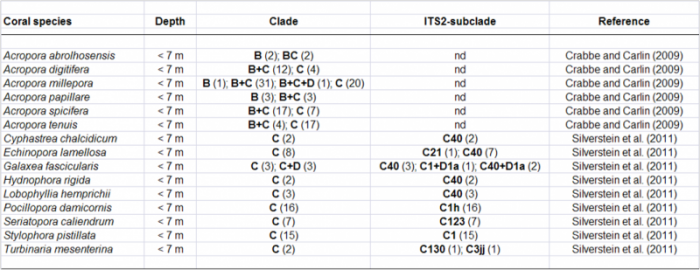Home > Browse by Institution > Australian Institute of Marine Science > Zooxanthellae (Symbiodinium) diversity on Ningaloo Reef
Zooxanthellae (Symbiodinium) diversity on Ningaloo Reef
- Ningaloo Atlas
- Australian Institute of Marine Science
Coral reefs have persisted in tropical seas for millions of years largely due to the symbiosis between reef-building corals and zooxanthellae. Zooxanthellae are microscopic algae (belonging to the genus Symbiodinium) that live within the coral’s tissues. The zooxanthellae photosynthesise using the sun’s light energy, providing up to 90 % of a coral’s energy requirements. In return, the coral provides the zooxanthellae with protection, nutrients (mostly waste material containing nitrogen and phosphorus), and a constant supply of carbon dioxide required for photosynthesis.
To date, nine major clades (clades A to I) of Symbiodinium have been identified, with Clades A, B, C, D, F, and G being present in reef-building corals. The different clades have been shown to exhibit distinct geographical distributions at both large and small scales, as well as showing intraspecific depth zonation. Advances in molecular techniques have further divided the clades into subcladal types that have further unraveled biologically relevant patterns such as host specificity, niche diversification, physiological differences, and bleaching susceptibility between subcladal types.
While there is a wealth of literature on zooxanthellae diversity from many coral reef regions (including the Great Barrier Reef and the Caribbean), very limited information exists for Ningaloo reef. Two studies (Crabbe and Carlin 2009; Silverstein et al. 2011) have looked at zooxanthellae diversity on Ningaloo at depths < 7 m. In both cases Clade C was the dominant type in the 15 species representing 10 genera on Ningaloo Reef (Table 1). Clade B was present in Acropora and isolated occurrences of Clade D were found in Acropora millepora and Galaxea fascicularis. Perhaps more importantly, the corals on Ningaloo Reef display a number of previously undescribed subcladal types.
Table 1. Symbiodinium cladal and subcladal diversity reported from Ningaloo reef. Numbers in parentheses represent number of colonies containing that Symbiodinium type. nd = no data. |
Despite the limited taxa and sample sizes, diverse and novel zooxanthellae communities have been found on Ningaloo Reef, indicating that understudied reef systems may contain zooxanthellae diversity that is previously undescribed. Given that the identity and diversity of zooxanthellae in reef-building corals is thought to influence the resilience of reef ecosystems to climate change, a more comprehensive assessment of Symbiodinium diversity on Ningaloo Reef will provide interesting and important results to aid scientists and managers to understand how the corals on Ningaloo Reef respond to the predicted increases in sea surface temperatures.
For more information on the zooxanthellae diverity on Ningaloo Reef, see Crabbe, MJC and Carlin JP (2009), and Silverstein RC, Correa, AMS, LaJeunesse TC and Baker AC (2011), or contact the corresponding authors, Prof. James Crabbe and Ms Rachel Silverstein.
Dataset details
| Data extracted from Crabbe and Carlin (2009) and Silverstein et al. (2011) |








